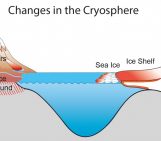
So this is the last post in 2022 for our blog. We have decided that this time, the topic will not be another exciting story about the science of ice and cold in their various forms. This time we are talking about the blog itself, so a kind of meta-post to take stock and understand a little better how our blog works, what it is about, and who our main authors are. To this purpose, we asked all the authors who published posts this year to answer a few questions to get some insights on our demographics and gather some statistics. Here, we answer 5 questions with the help of graphs.
1. Who are our 2022 authors?
This year’s blog was made possible thanks to 46 authors working in 16 different countries (see map below). Most of the authors (90 %) are between 25 and 44 years old. Also, we found out that people from all over the world are reading our blog: in total from 169 countries (~87% of the world’s countries)!
2. What were the most common words this year?
These are the 50 most common words used in our blog in 2022! You can’t find words describing your research interests? That means we need more blog posts about your topic! Get in touch with us if this is the case and you would like to write a blog post!
3. Where do our 2022 authors work?
Our 2022 authors are based in 16 countries, as shown on this map (projection: Robinson)! We recognize that the Global South is underrepresented and want to work to improve this. If you are a scientist from the Global South with one (or multiple!) nice stories about (your research on) the Cryosphere, please contact us.
4. What cryospheric elements are the authors working on?
The most popular cryospheric elements that our authors are working on this year are ice sheets, glaciers and sea ice! Probably most research fields related to the Cryosphere are covered by these topics, but some are less so! New topics are also very welcome in the blog! We’ve been very glad to host more stories about work-life balance, mental health and research in everyday life (check out for example this and this post).
5. What were the most frequent blog categories?
In total, we had posts spanning 16 categories this year. Here you can see that most posts were in our category “Climate Change & Cryosphere”. This is not unexpected: we all know that ice, and in general the Cryosphere, are sentinels of climate change and they are reacting rapidly to it. Of course scientists, and so also our authors, are observing these processes very carefully. Recently, we also started a new category: Cryoscience & Art (see this post)! So if you have nice ideas linking science and arts, let us know!
Next year’s Cryoblog
As you can see, we have covered quite a few topics in this year’s blog once again. Next year, we would like to encourage more variety in our blog and therefore, we encourage former and new authors to tell us all about their experiences, research, livelihoods, art and much more in the Cryosphere. The Cryoblog is a fun way to communicate (your) science! The editorial team works hard to help you publish your post on our blog. You are also welcome to join our editorial team if you are interested in helping out with editing blog posts.
Here are a few simple steps we generally recommend to take to write a post for our blog:
- contact our chief-editors via email and let us know your availability (Giovanni Baccolo or Loeka Jongejans)
- we will send you the blog template and together we will set a date
- you write a blog post and send it to us (1-2 weeks ahead of the publishing date)
- our editors go over your text and are in contact with you to arrive at a form and content that you are happy with. We are especially dedicated to helping you write in a style that is understandable to all!
- on the selected Friday morning, we will publish your blog post and advertise it across all our social media platforms!
We wish you all the best for the holiday season and an amazing new year. We hope to see you after the break on 13 January 2023!
The EGU Cryoblog Team











Di Liu
How we obtain the snow/ice cover change during the polar winter period? SAR or surveys?